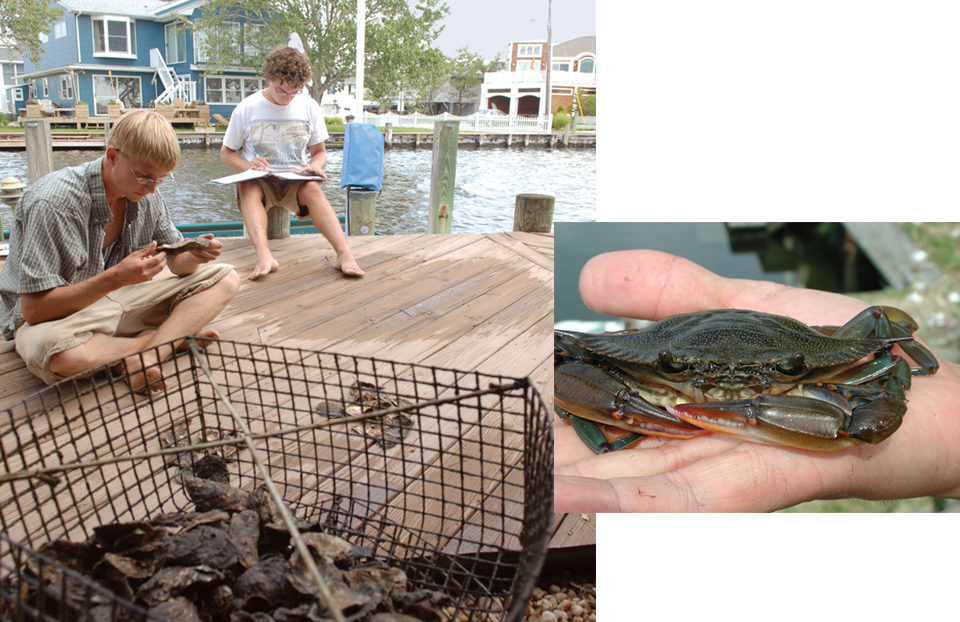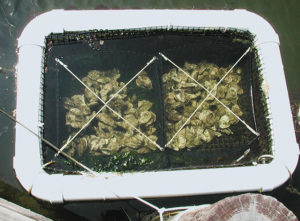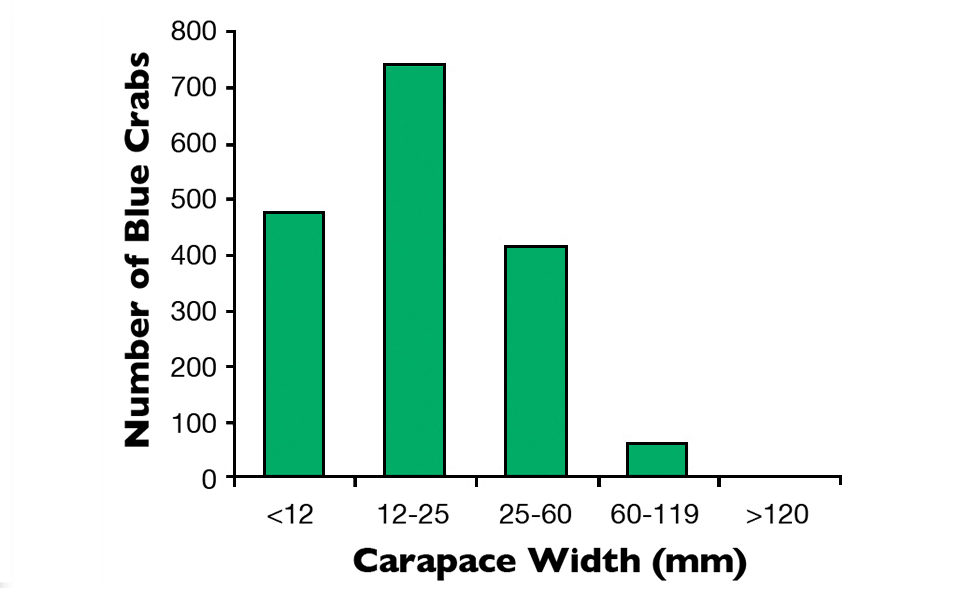Restoration efforts on Fenwick Island, Delaware, attracts participants of all ages

The blue crab fishery of the Chesapeake Bay on the eastern cost of the United States was designated a federal fishery disaster by the U.S. Department of Commerce in September 2008. Nearby, Delaware’s inland bays have experienced similar declines in nursery habitats such as oyster reefs and seagrasses. Juvenile blue crabs rely on such habitat for refuge during their critical first years of life.
Blue crabs occur in most estuaries in the mid-Atlantic year-round. They make short seasonal migrations from shallow estuarine waters in the spring and summer to deeper coastal waters at the mouths of bays. Discovering surrogate habitat for the oyster beds that historically offered cover for their movements could aid the blue crab recovery.
In a study, the authors addressed the use of “Taylor floats” as habitat for juvenile blue crabs. Taylor floats are inexpensive floating cages constructed of plastic pipe and plastic-coated wire mesh.
Oyster gardens
Eight residential properties located on the Little Assawoman Bay in Delaware and belonging to oyster-gardening volunteers were selected as study sites. Beginning May 26, 2008, three Taylor floats were spaced approximately five lengths apart at each site. One contained live oysters, one held oyster shells and the third had no shells or oysters.
Four sites were cleaned biweekly by thoroughly spraying the floats and contents with a garden hose. The remaining sites were cleaned on a monthly basis in the same manner.
All floats were sampled monthly for fish and macroinvertebrates by surrounding the float with a 3-mm-mesh net, pulling the netted float out of the water, spraying the float and contents with a garden hose and retrieving all specimens collected in the net. Blue crabs – including molting crabs and empty shells – were part of the extensive list of species that were counted and measured.
Floating refuge

Over the course of the four-month study, 1,696 blue crabs were sampled with an average 18 crabs/float found during the study. One float contained 166 blue crabs, and four others had over 100 blue crab individuals. Thirty-five freshly molted crabs were found in the floats, and 23 empty shells were discovered, suggesting the substrate provided valuable refuge, especially for vulnerable soft-shell juveniles
Significantly more blue crabs were collected from floats with oyster clusters and loose shells than empty floats during July and August, the months with the highest abundance of crabs. Only one blue crab was of market size greater than 120 mm, and 96.3 percent of all crabs collected were under 60 mm in width. The largest crabs were collected in June, and the smallest were collected in July.
Blue crab carapace widths were progressively higher in August and September. The mean daily growth rate between July and September was 0.14 ± 0.11 mm. The cleaning frequency of the floats did not result in any difference in blue crab abundance or distribution.
Safety from predators
Taylor floats are beneficial for juvenile blue crabs because the 25-mm openings in the wire baskets of the floats provide safety from predation by larger blue crabs and other predators unable to fit through the wire mesh. The average size of all blue crabs was only 21.6 mm (Figure 1). While the mesh size caused an obvious bias toward capturing crabs of smaller size, this was significant because the critical early life stages are likely the most habitat-limited in the inland bays.

Theoretically, improved survival could lead to increased blue crab production even if growth rates are constant. More data needs to be gathered to confirm whether juvenile blue crabs residing in oyster gardens are experiencing increased survival compared to other areas, and to what extent floating oyster gardens provide juvenile blue crabs a refuge from predation.
Perspectives
Nonethless, while working with these oyster floats and talking with the townspeople of Fenwick Island, Delaware, the authors saw the value of the simple floats – not only to the environment but also to the people involved. Both young and old were excited to be part of a restoration effort in their waters, and many passersby seemed to genuinely ponder the quality of the water.
The volunteer oyster-gardening program in Delaware’s inland bays has grown exponentially since it began in 2003, showing that once residents are armed with knowledge and trouble-free means, grass-roots habitat stewardship can emerge in a densely populated shore community. Information about the importance of oyster habitat to the blue crab fishery within the estuarine ecosystem will serve to better protect the fisheries and habitat on which so many depend.
(Editor’s Note: This article was originally published in the July/August 2010 print edition of the Global Aquaculture Advocate.)
Now that you've finished reading the article ...
… we hope you’ll consider supporting our mission to document the evolution of the global aquaculture industry and share our vast network of contributors’ expansive knowledge every week.
By becoming a Global Seafood Alliance member, you’re ensuring that all of the pre-competitive work we do through member benefits, resources and events can continue. Individual membership costs just $50 a year. GSA individual and corporate members receive complimentary access to a series of GOAL virtual events beginning in April. Join now.
Not a GSA member? Join us.
Authors
-
Gulnihal Ozbay, Ph.D.
Project Director
Delaware State University
Department of Agriculture and Natural Resources
1200 North Dupont Highway
Dover, Delaware 19901 USA -
Aaron Gibson
Project Director
Delaware State University
Department of Agriculture and Natural Resources
1200 North Dupont Highway
Dover, Delaware 19901 USA
Related Posts

Responsibility
Examining copper use in aquaculture
Copper is used for control of the blue-green algae responsible for off-flavors in aquaculture animals, treating diseases and parasites, and avoiding cage net fouling. Although copper is an essential nutrient for plants and animals, an excess can negatively affect the environment and human health.

Health & Welfare
Flatfish conditioning for stock enhancement
Acclimation cages, the most implemented conditioning strategy for flatfish, are inexpensive and effective, but require site-specific adjustment. Live or lifelike diets show great potential in rearing stocked flatfish.

Health & Welfare
Recent developments in biofloc technology
Combining biofloc technology with bio-secure modular shrimp culture can make operations more sustainable and economically viable. For optimized biofloc production, lined ponds and reservoirs and high stocking densities are essential. Paddlewheel aerators keep dissolved-oxygen levels high.

Health & Welfare
Artificial upwelling maintains favorable summer environment for farmed oysters
The summer season poses threats for oyster aquaculture worldwide. In addition to high mortality, poor oyster quality and health – especially in enclosed bays – are often attributed to water stratification, high temperatures and hypoxia.


